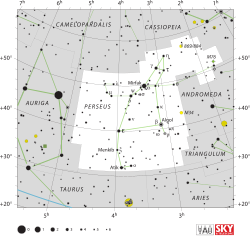
Back Perseus (sterrebeeld) Afrikaans حامل رأس الغول (كوكبة) Arabic پيرسيوس (كوكبه) ARZ Persey (bürc) Azerbaijani Персей (йондоҙлоҡ) Bashkir Персей (сузор’е) Byelorussian Пэрсэй (сузор’е) BE-X-OLD Персей (съзвездие) Bulgarian পরশু (তারামণ্ডল) Bengali/Bangla དྲང་སྲོང་དཔའ་བོའི་སྐར་ཚོམ་ Tibetan
| Constellation | |
 | |
| Abbreviation | Per |
|---|---|
| Genitive | Persei |
| Pronunciation | /ˈpɜːrsiːəs/ or /ˈpɜːrsjuːs/; genitive /ˈpɜːrsiː.aɪ/ |
| Symbolism | Perseus |
| Right ascension | 3 |
| Declination | +45 |
| Quadrant | NQ1 |
| Area | 615 sq. deg. (24th) |
| Main stars | 19 |
| Bayer/Flamsteed stars | 65 |
| Stars with planets | 7 |
| Stars brighter than 3.00m | 5 |
| Stars within 10.00 pc (32.62 ly) | 0 |
| Brightest star | α Per (Mirfak) (1.79m) |
| Messier objects | 2 |
| Meteor showers | Perseids September Perseids |
| Bordering constellations | Aries Taurus Auriga Camelopardalis Cassiopeia Andromeda Triangulum |
| Visible at latitudes between +90° and −35°. Best visible at 21:00 (9 p.m.) during the month of December. | |
Perseus is a constellation in the northern sky named after Perseus, the mitological greek hero.[1] Perseus is located in the northern celestial hemisphere.[2][3] The brightest star in Perseus is Alpha Persei, that has an apparent magnitude (brightness as viewed from Earth) of 1.8.[1] The best-known star in Perseus is Algol, which is known by its variability in brightness, that can be noted by the naked eye.[4] Algol is a star system formed by multiple stars, of which two eclipses each other and creates the brightess variation.[4] The Perseids are a meteor shower located in Perseus, that are proeminent during the months of July and August.[5] Perseus' border constellations are: Aries, Taurus, Auriga, Camelopardalis, Cassiopeia, Andromeda and Triangulum.
- ↑ 1.0 1.1 "Perseus | Mythology, Stars, Constellations | Britannica". www.britannica.com. Retrieved 2024-03-01.
- ↑ Waldek, Stefanie (2019-11-20). "Perseus constellation: Facts, location and myth". Space.com. Retrieved 2024-03-01.
- ↑ "Chandra :: Photo Album :: Constellation Perseus". chandra.harvard.edu. Retrieved 2024-03-01.
- ↑ 4.0 4.1 "Perseus the Hero and a Demon Star | Sky Archive | EarthSky". earthsky.org. 2022-10-27. Retrieved 2024-03-01.
- ↑ "The Perseus Constellation | Pictures, Facts, and Location". AstroBackyard. Retrieved 2024-03-01.